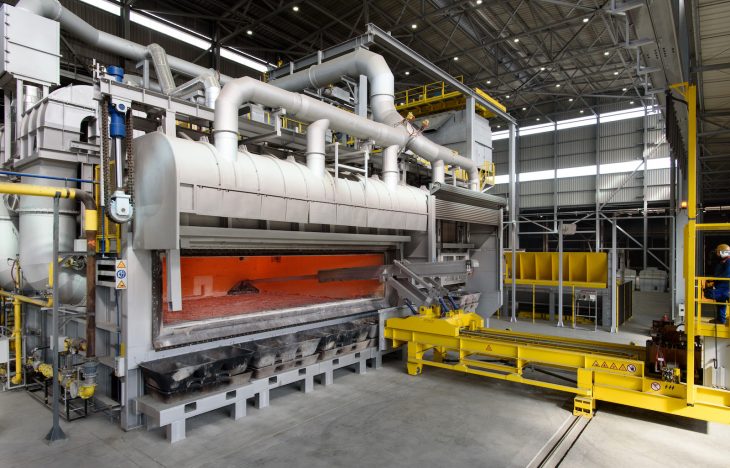The recycling of manufacturing and turnaround scrap is becoming more and more important within the extrusion industry. Hydro Extruded Solutions currently processes aluminum scrap at a number of facilities, with more than half of their extrusion production coming from recycled material. The company aims to have a total of 20 of its extrusion plants achieve Aluminium Stewardship Initiative (ASI) certification for environmental and social stewardship by the end of 2019. In line with this goal, Hydro installed a new aluminum multi-chamber melting furnace and a rail-guided skimming machine at Hydro Extrusion Lichtervelde NV in Ghlin, Belgium.
New Melting Furnace
As part of Hydro’s global network, the Ghlin remelt plant is responsible for the supply of extrusion billets. The site utilizes a wide range of scrap types used as input material, including: vehicle license plates, wires, machining chips, cables, litho sheets, profiles, UBCs, aerosol cans and others. The scrap material is supplied is either partially loose in bulk, partially shredded, partially briquetted, or packed. The degree of contamination ranges from “clean” scrap all the way up to heavily contaminated scrap with paint and lacquers, rubber and plastic parts, oils, greases, etc. Furthermore, solid shapes such as sows, T-bars, or ingot stacks are also charged. Due to the high variety of input materials used, Hydro selected an Ecomelt-PS200 melting furnace with preheat shaft from Hertwich Engineering, part of the SMS group. The furnace has a melting capacity of 60,000 tons per year.
All processing steps for the new melting furnace — starting from the scrap supply all the way down to molten metal tapping — are integrated into one compact and fully automated system. These steps are all monitored and managed using control instruments and systems in order to ensure a high metal quality.
During operation, the scrap is loaded into a container that is then lifted onto a platform above the vertical preheat shaft (which can reach a maximum temperature of up to 650°C). The scrap is charged into the shaft based, where the material is preheated to around 500°C — a temperature rang that is able to remove any organic compounds from the scrap without melting it. This minimizes melt loss (especially important for thinner materials), as the decoated and preheated material is directly immersed the liquid melt flow at the bottom of the preheating shaft. Metal losses are limited to 0.3–3%, depending on scrap condition and degree of contamination — compared to traditional furnaces, which show losses around 0.5 to more than 10% for the same type of material.
The furnace includes electromagnetic liquid metal pumps, which maintain the required melt level and flow rate and provide circulation between melting and main chambers. A pneumatically actuated double plug and cone tapping system performs tapping and transport of molten metal from the furnace to the launder system. This keeps the melting process from being interrupted.
The Ecomelt melting technology developed by Hertwich is based on the internal use of the energy content of organic impurities removed from the scrap. The pyrolysis gases — created during the decontamination of the scrap in the preheat shaft — are fed into the main furnace chamber, where they are reused to support the gas heating system. This reduces energy consumption, since the hot air is able to flow between the main chamber, melting chamber, and preheat shaft to facilitate the preheating and melting process. According to Hertwich, this furnace type has an energy consumption of 300–600 kWh/t for (depending on the scrap type and degree of contamination) and can reduce gas consumption by up to 50% compared to traditional furnaces.
The furnace also provides an excellent environmental performance, with a low CO2 output and minimum emissions (NOx, VOC, no salt usage). Possible harmful dioxine and furane emissions are prevented through rapid quenching of furnace flue gases — undercutting the critical temperature range between 600 and 250°C in which formation of these compounds could take place. Furthermore, acid gases are neutralized and dust particles are separated in the flue gas filter plant. The cleaned flue gases comply with all typical emission regulations being in force globally.

